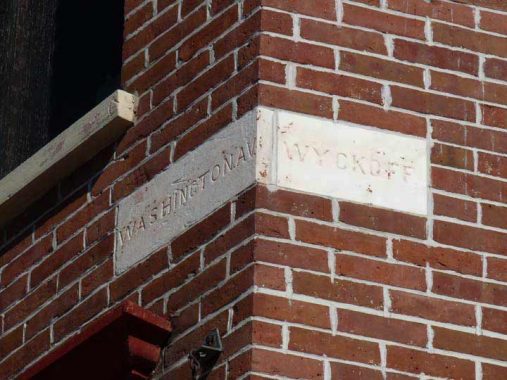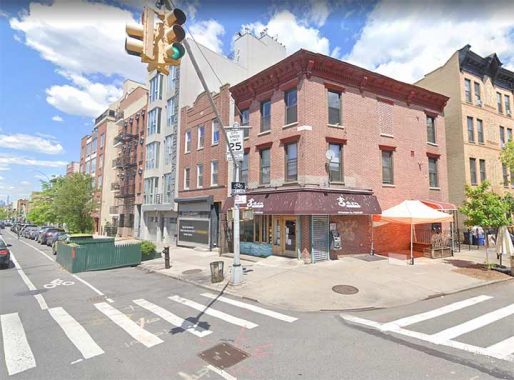
YOU can observe a lot just by looking, as Yogi Berra used to say. For example, here’s a handsome brick building on Washington and st. Mark’s Avenues at the edge of Crown Heights that goes back quite a few decades and fortunately, looks pretty much the same as it always did. What’s unusual about it?

It has a pair of chiseled street signs. This used to be the favored method of street signage; signs mounted on lampposts or phone poles didn’t come until the early 20th Century, when lampposts got large enough to pull that duty.
But instead of St. Mark’s Avenue it simply says “Wyckoff.” That’s a clue that at one time, St. Mark’s Avenue was called Wyckoff Street. There happens to be a Wyckoff Street in Brooklyn, named for Dutch immigrants in the colonial era, but it’s way west in the Cobble Hill-Gowanus areas. At some point, it was renamed in pieces. Between 3rd and 5th Avenues, it was renamed St. Mark’s Place and from 3rd Avenue all the way to its east end at East New York Avenue at the Howard Houses in Brownsville, it became St. Mark’s Avenue.
In fact if you take a look at this map from 1866, not only Wyckoff but Warren, Baltic, Butler, Douglass, DeGraw and Sackett Streets were also much longer, crossing Bedford-Stuyvesant in their miles-long lengths. But between 1874 and 1881, their names were all changed, with Sackett east of Washington Avenue swallowed up by Eastern Parkway , which was built in the early 1870s.
What happened? Murder happened. On March 20, 1873, Lizzie Lloyd King, a.k.a. Kate Stoddard, shot dead her boyfriend, Charles Goodrich, who wished to break off the relationship, at 731 Degraw, just west of 5th Avenue (the address has been renumbered since) . She fled with several of Goodrich’s possessions before returning the next day to clean and dress the corpse before going to her job at a hat factory. Just another day in Park Slope. After a three-month investigation, aided by Stoddard’s friend Mary Handley, the murderer was apprehended and sentenced to the State Lunatic Asylum in Auburn, NY; the building still stands. A 2013 play by Claudia Barnett examined the murder in the context of the works of Emily Dickinson.
Real estate values in the area dropped as a result of the murder. As a result, the decision was made to change Degraw Street’s name, and the other parallel streets in the area followed suit between 1874 and 1881. Warren and Baltic became “Prospect” and “Park,” a bit clever, for nearby Prospect Park; Butler, “Sterling Place’ for William Alexander, Lord Stirling, who led the patriots in the Revolutionary battle at the Old Stone House; Douglass (the name isn’t connected with abolitionist and orator Frederick Douglass) became St. John’s Place, for St. John’s Episcopal Church, built in 1870 on Douglass in 1870; Degraw became Lincoln Place, for Abraham Lincoln; and Sackett became Berkeley Place, for Irish philosopher and Anglican minster George Berkeley (1685-1753), for whom Berkeley, CA is also named.
Meanwhile, Wyckoff Street becomes St. Marks Place at 3rd Avenue and then, St. Mark’s Avenue at 5th Avenue. The name puzzles me, since the nearest St. Mark’s Church is the Episcopal church at Brooklyn Avenue and Union Street in Crown Heights.
Much more on this can be found on FNY’s Douglass Street page.
Meanwhile, this ancient carven sign reminds us of a time before a murder changed Brooklyn’s street map.
As always, “comment…as you see fit.” I earn a small payment when you click on any ad on the site.
11/22/21
